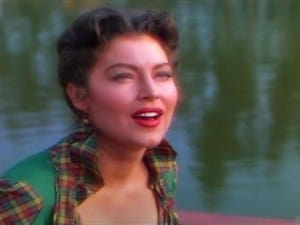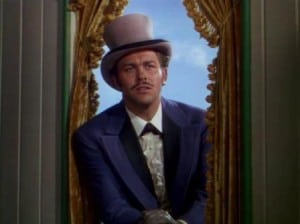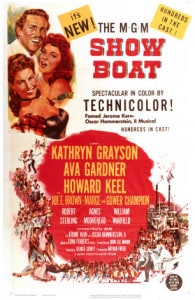HERE IT COMES! The M-G-M SHOW BOAT!
Yes, it might be well to remember that this Show Boat is the 1951 remake, preceded by two other versions, the 1936 “all-sound” and the 1929 early talkie, mostly silent with songs added to accommodate the then change-over to sound. And remember, too, that, although this ’51 version is part of a new twenty-film box set of musicals from Warner Brothers, this Show Boat is actually from M-G-M, the foremost producer of musicals.
There has been much debate about which of the two sound versions is the better acted and sung, the more faithful to Edna Ferber’s novel, the more watchable as pure entertainment. The 1929 version is deservedly forgotten now, not only because of its telling age, but because many of the songs, poorly staged to begin with, are not by Jerome Kern and Oscar Hammerstein II.
The 1936 version of this, yet another story of the Old South, is, over-all, equal to the later version, but preferred by most critics. Irene Dunne is top-billed in the role of Magnolia, the new, up-coming star of a Mississippi riverboat. Gaylord Ravenal, the show’s main attraction, is played by Allan Jones, an opera-trained professional, who maintained his career—and vibrant singing voice—until a few weeks before his death at eighty-four.
Ravenal falls in love and marries Julie (Helen Morgan, a famous torch singer of the day), though it is discovered that she has what was then called “Negro” blood. The idea of miscegenation, a word created during the American Civil War to denote intermarriage between whites and African-Americans, was a delicate topic for the Hays Office. Not allowed in the 1929 version, it was sanctioned in ’36 and, since a precedent had been set, permitted in ’51 despite opposition.
The ’36 version, perhaps the most faithful to the novel, has another vocal advantage in Paul Robeson, though a politically controversial singer. As Joe the slave, he sings the musical’s most famous and enduring number, “Ol’ Man River.” Hattie McDaniel in the role of Queenie is quite superior to her counterpart in ’51, Frances E. Williams. The film’s director, James Whale of Frankenstein and The Invisible Man fame, rated this his favorite movie of all those he directed.
 Too much about the ’36 version? Perhaps. But be sure and see it on DVD.
Too much about the ’36 version? Perhaps. But be sure and see it on DVD.
As for the ’51 Show Boat, the version in the WB box set, besides the Technicolor, a visual plus is the gorgeous [intlink id=”265″ type=”category”]Ava Gardner[/intlink] as Julie LaVerne. Annette Warren dubbed her singing voice, which Gardner lip-sings perfectly. As for Magnolia, some viewers may find Warren’s voice more pleasing than Kathryn Grayson’s. She was an opera-trained coloratura, and the high, thin notes may be a bit off-putting to some listeners.
All is forgiven, however, in the rich baritone voice of the lusty, six-foot, four-inch Howard Keel, truly one of the wonders of the Hollywood musicals of the ’50s, and Grayson’s co-star in two other such films. As Gaylord Ravenal, he gives the impression that it doesn’t matter which girl he gets in the end as long as he can sing to her. Allan Jones’ voices seems anemic and undernourished in comparison.
Keel met his equal, however, in William Warfield, the bass-baritone who, as Joe, sings the best-remembered scene in this version of Show Boat. Along a fog-drenched river, the showboat leaves the dock as Joe sings “Ol’ Man River.” Also opera-trained, Warfield was part of the vocal quartet in the Mozart Requiem conducted by the great Bruno Walter at Carnegie Hall and recorded in 1956. In 1958, Warfield premiered Set Two of Aaron Copland’s Old American Songs, with the composer at the piano.
 The show abounds with wonderful songs that are staples of the American musical theater. The best of the lot are “Make Believe,” “Can’t Help Lovin’ Dat Man,” “Where’s the Mate for Me?,” “Why Do I Love You?” and, of course, “Ol’ Man River.”
The show abounds with wonderful songs that are staples of the American musical theater. The best of the lot are “Make Believe,” “Can’t Help Lovin’ Dat Man,” “Where’s the Mate for Me?,” “Why Do I Love You?” and, of course, “Ol’ Man River.”
Show Boat, which premiered at the National Theatre in Washington, D.C., November 15, 1927, was one of the milestone musicals. Every critic has said it—and it’s true: the history of the American musical can be divided into before and after Show Boat. Musicals before Show Boat were basically of a frivolous nature, with a simple boy-meets-girl scenario, a string of unrelated songs, broken by equally unrelated, often silly dialogue. By comparison, Show Boat had a cohesive story, the songs were linked to both the plot and the dialogue and, beneath that surface of lovely songs, the subjects were serious ones—slavery and intermarriage. This opened the way for such theme-driven and moral-message musicals as South Pacific, West Side Story and Les Misérables.
Thanks as always to Warner Brothers for the review copy.
